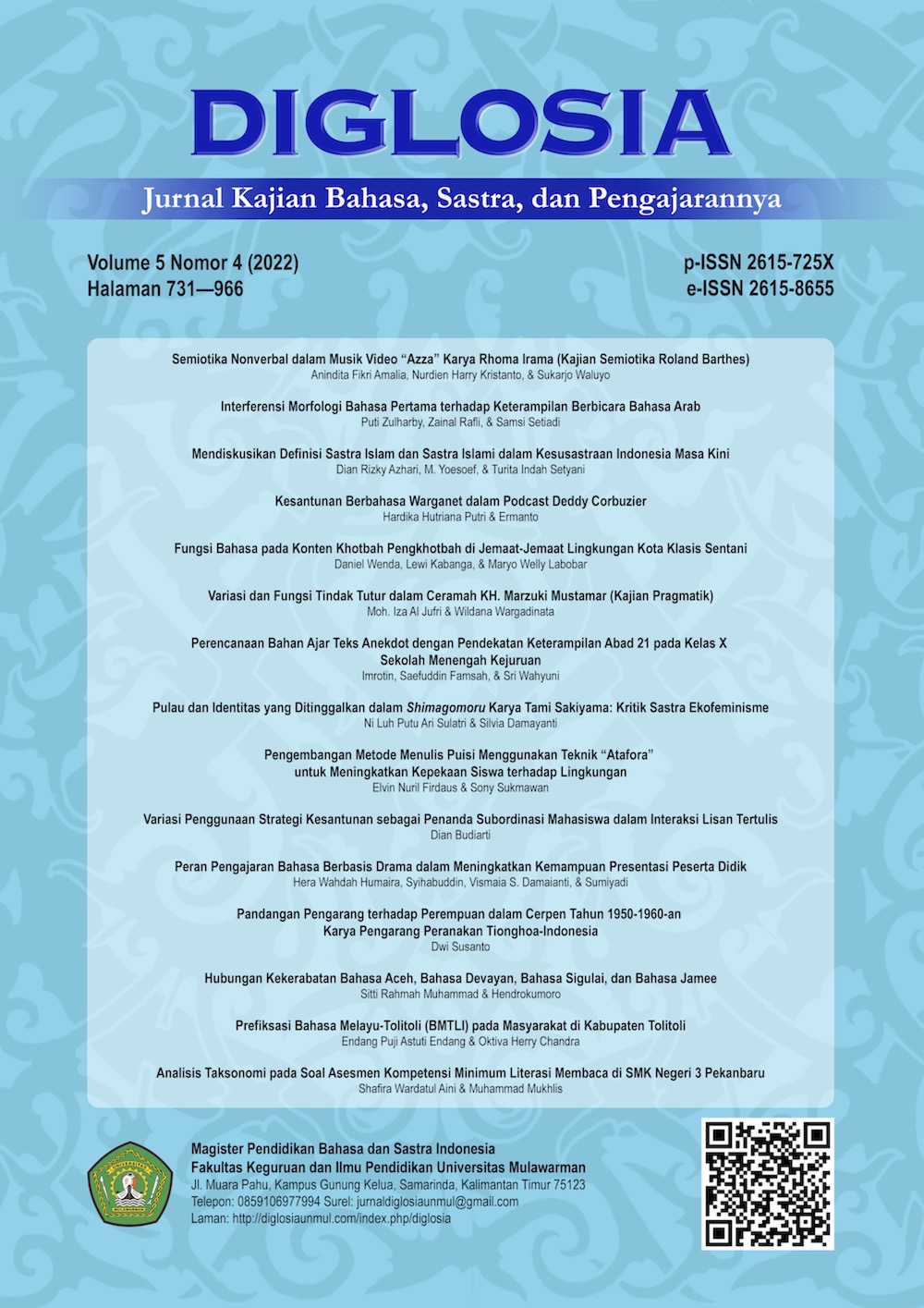Semiotika Nonverbal dalam Musik Video “Azza” Karya Rhoma Irama (Kajian Semiotika Roland Barthes)
Main Article Content
Abstract
This study aims to describe non-verbal semiotics and its relation to Roland Barthes' semiotics, namely connotation and denotation. This research with the object of the study of the music video "Azza" by Rhoma Irama uses qualitative research methods to find non-verbal semiotics contained in the object of study. The results of this study, namely in the music video "Azza" by Rhoma Irama, there are seven body signs, namely (a) signals; (b) facial expressions; (c) eye contact; (d) body language; (e) touch; (f) cue; and (g) dance. It is also related to Roland Bathes' semiotics. Signs expressed in the music video have connotative and denotative meanings that the singer wants to convey through his music and videos. The connotative meaning in the music video "Azza", sung by Rhoma Irama, can be seen in the scenes glorifying God's power.
Downloads
Article Details
![]()
Every work in Diglosia: Jurnal Kajian Bahasa, Sastra, dan Pengajarannya is licensed under a Creative Commons Attribution-ShareAlike 4.0 International License.
Under the following terms:
- Attribution — You must give appropriate credit , provide a link to the license, and indicate if changes were made . You may do so in any reasonable manner, but not in any way that suggests the licensor endorses you or your use.
- ShareAlike — If you remix, transform, or build upon the material, you must distribute your contributions under the same license as the original.
- No additional restrictions — You may not apply legal terms or technological measures that legally restrict others from doing anything the license permits.
Authors who publish with this journal agree to the following terms:
- Authors retain copyright and grant the journal right of first publication with the work simultaneously licensed under a CC BY-SA 4.0 DEED Attribution-ShareAlike 4.0 Internationalthat allows others to share the work with an acknowledgment of the work's authorship and initial publication in this journal.
- Authors are able to enter into separate, additional contractual arrangements for the non-exclusive distribution of the journal's published version of the work (e.g., post it to an institutional repository or publish it in a book), with an acknowledgment of its initial publication in this journal.
- Authors are permitted and encouraged to post their work online (e.g., in institutional repositories or on their website) prior to and during the submission process, as it can lead to productive exchanges, as well as earlier and greater citation of published work.
References
Barthes, R. (1972). Mythologies. Hill and Wang.
Barthes, R. (1977). Image-Music-Ttext. Fontana.
Berger, A. A. (2010). Pengantar Semiotika: Tanda-Tanda dalam Kebudayaan Kontemporer. Tiara Wacana.
Bimantoro, W. (2016). Semiotik Bahasa Tubuh sebagai Idiom Komunikasi Verbal pada Iklan Sampul Majalah. Jurnal Dimensi Seni Rupa Dan Desain, 3(1), 35–51. https://doi.org/10.25105/dim.v3i1.1497
Carlsson, S. E. (1999). Audiovisual Poetry or Commercial Salad of Images? Perspective on Music Video Analysis. http://filmsound.org/what_is_music_video/
Danesi, M. (2010). Pesan, Makna, dan Tanda. Jalasutra.
Djohan. (2009). Psikologi Musik. Best Publisher.
Eco, U. (1976). A Theory if Semiotics. Indiana University.
Effendy, O. U. (2002). Ilmu Komunikasi Teori dan Praktek. PT Remaja Rosdakarya.
Fazira, E., Rahmawati, R., & Asman, Z. (2021). Analisis Semiotika Representasi Rasa Kehilangan Dalam Musik Video Klip Pilu Membiru Experience. Jurnal Ilmiah Mahasiswa Fakultas Ilmu Sosial & Ilmu Politik, 6(2). http://jim.unsyiah.ac.id/FISIP/article/view/16786
Fiske, J. (1990). Cultural and Communication Studies: Sebuah Pengantar Paling Komprehensif. Jalasutra.
Hikmah, N., & Faidah, M. (2019). Rekayasa Tata Rias Wajah Pengantin Arab Modern. Jurnal Tata Rias, 8(3), 69–71. https://ejournal.unesa.ac.id/index.php/jurnal-tata-rias/article/view/30146
Irama, R. (2010). Azza (Official Music Video). SKI Records. https://www.youtube.com/watch?v=uOStp8-o8JU
Luxemburg, J. van. (1984). Pengantar Ilmu Susastra. Gramedia.
Morris, D., Marsh, P., Collett, P., & O’Shaughnessy, M. (1979). Gestures: Their Origins and Distributions. Jonathan Cape.
Opsantini, R. D. (2014). Nilai-Nilai Islami dalam Pertunjukan Tari Sufi pada Grup “Kesenian Sufi Multikultur” Kota Pekalongan. Jurnal Seni Tari, 3(1), 1–13. https://journal.unnes.ac.id/sju/index.php/jst/article/view/3969
Pradopo, R. D. (2014). Pengkajian Puisi. Gadjah Mada University Press.
Ramadhanty, C. B. (2020). Resistansi terhadap Objectification dalam Novel Mash-Up Pride and Prejudice and Zombies dari Novel Klasik Pride and Prejudice. Diglosia: Jurnal Kajian Bahasa, Sastra, Dan Pengajarannya, 3(1), 33–45. https://doi.org/10.30872/diglosia.v3i1.30
Saefuddin. (2019). Nilai-Nilai Pendidikan Islam dalam Lirik-Lirik Lagu Dangdut Rhom Irama: Suatu Pendekatan Hermeneutika-Semiotika. Medina-Te: Jurnal Studi Islam, 15(2), 215–246. http://jurnal.radenfatah.ac.id/index.php/medinate/article/view/4402
Saussure, F. de. (2013). Course in General Linguistics. Bloomsbury Academic.
Sobur, A. (2016). Semiotika Komunikasi. Remaja Rosdakarya.
Tarmini, W. (2009). Kata Tanya dalam Konstruksi Interogatif Bahasa Indonesia: Kajian Sintaktis dan Semantis. Sosiohumaniora, 11(1), 77–92. https://doi.org/10.24198/sosiohumaniora.v11i1.5580
Tinarbuko, S. (2017). Semiotika Tanda Verbal dan Tanda Visual Iklan Layanan Masyarakat. Panggung, 26(2), 181–194. https://doi.org/10.26742/panggung.v26i2.175
Turner, G. (1992). British Cultural Studies: Na Introduction. Routledge.
Wundt, W. (1973). The Language of Gesture. Mouton.

